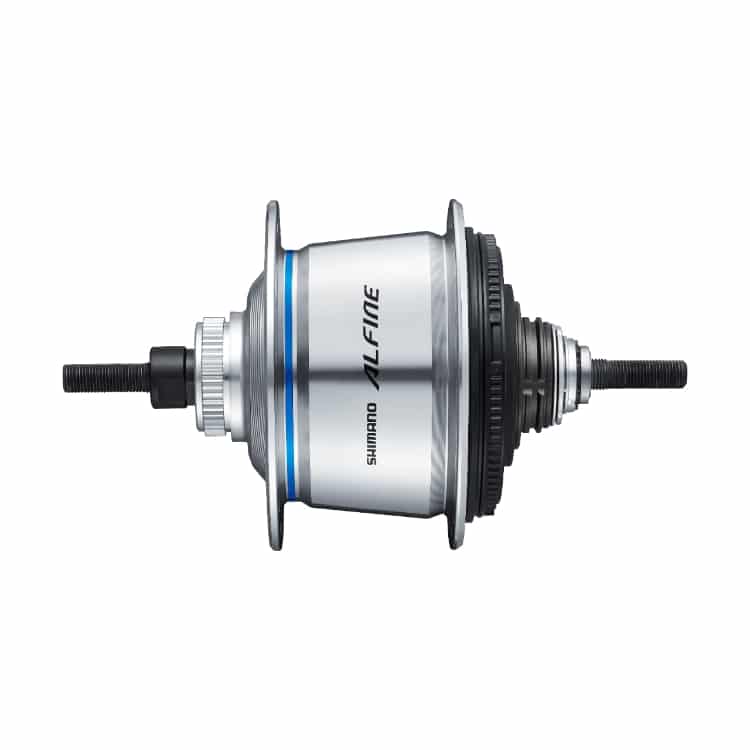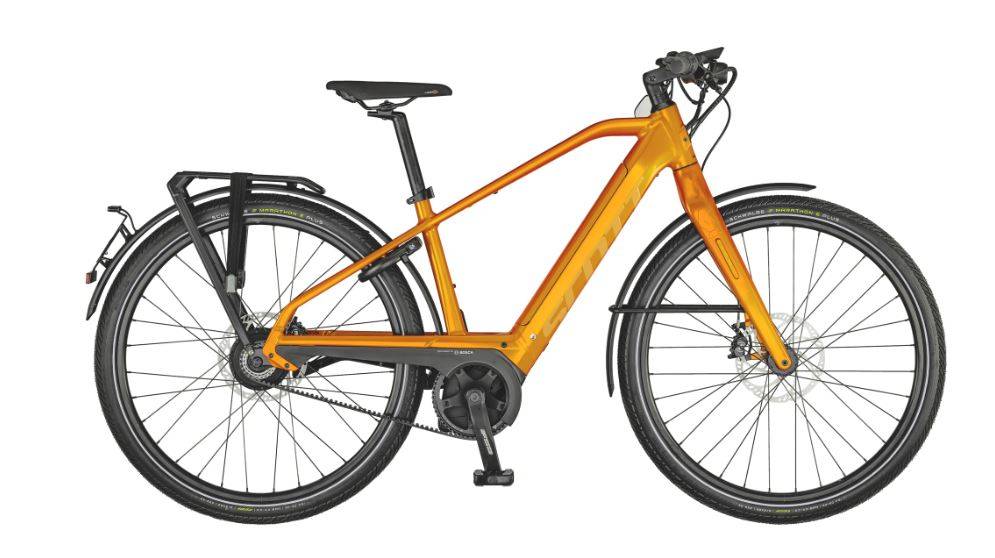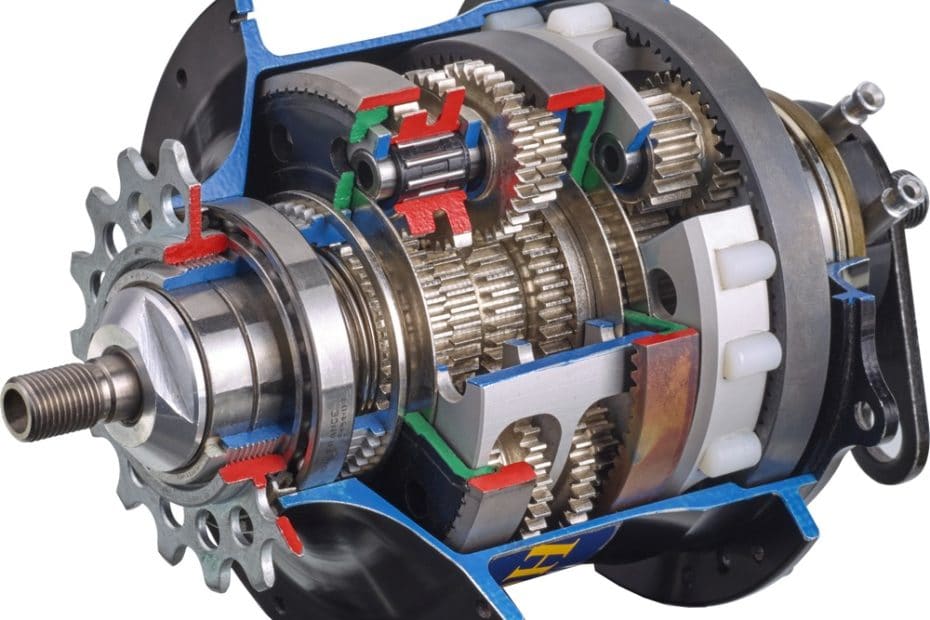A hub derailleur is a groupset in which the gear ratio selection system is internal and enclosed in the body of the rear hub.
- How hub gears are made
- Advantages
- Disadvantages
- Radial vs hub gears: how they change riding
- Who can best use hub gears
How a hub derailleur is made
The technology is very different from an external drivetrain, which consists of derailleurs that move the chain onto the sprocket pack or front sprockets. Here, the chain never moves, what changes are the couplings between the sprockets.
The system consists of a sprocket wheel called “solar” that is fixed on the pivot of the hub. On this toothed wheel are coupled other toothed wheels of smaller diameter and different number of teeth (indicated with the letter z), called “planetary”.

Shimano Alfine hub gears – courtesy of Shimano
Depending on the selection, one of the planetary sprockets will be made to work, thus allowing to lengthen or shorten the pedaling ratio. The transmission of the muscular force and therefore of the movement is allowed thanks to a crankset and a sprocket mounted on the hub, connected by a single speed chain.
Shimano Alfine hub gears
The currently most popular hub gears are 3, 5, 7-speed and the most modern 8, 9 up to 11-speed. The Shimano Alfine model, with a more cycling footprint, has increased the number of gears to 11 speeds, obviously using more planetary systems while the Nexus model, more focused on city use, is available with 3-7-8 internal speeds.
The selection of the ratios takes place as in a common mechanical groupset, i.e. by acting on a control placed on the handlebar.
Pros
Protection
The planetary gears that compose it are all inserted inside the body of the hub and are isolated from the outside by a system of seals. This ensures that the mechanisms are protected from the mud, water, humidity and atmospheric agents that stress the traditional transmission system.
Low Maintenance
The planetary gear system operates in an oil bath, meaning it must be immersed in lubricant to function properly. Usually the hub is immersed in oil before being mounted on the wheel, and this operation is repeated at very long intervals.
In between these two phases there is practically no maintenance. In fact, it is not necessary to adjust the tension of the cables or the limit switches, the chain does not have to be washed and lubricated before each outing, and the wear of the chain is much more diluted over time, since working always in line does not create tensions and extratorsions.
Stationary shifting
Planetary gears can change gears even when the bicycle is stationary. This is not possible with external gearing, since the chain can only move up or down a sprocket if it is rotating (in fact, it is counterproductive to change while stationary with a traditional transmission).
This aspect is very advantageous, because it allows you, for example, to change gears when you are stopped at a traffic light, to be more agile and snappy as soon as the green light comes.
Practicality
Since the chain does not move, you can also protect it by using the classic casings of city bikes. This is not to be underestimated, as it allows you to “save” your pants from grease and allows you to safely use the same clothing that you will later wear at work.
Impact resistance
The dropout of the frame or the derailleur cage can bend as a result of a fall or a blow received. In the first case the problem can be solved by checking the flatness with a special tool and, if necessary, straighten the dropout.
In the second case, on the other hand, the only solution is to replace the derailleur, which, if our groupset is of high or very high quality, can be quite costly. With hub gears this problem does not exist.

A Scott Silence eRIDE Evo Speed with internal geared hub and belt drive
Possibility of belt installation
Thanks to the fact that the chain never moves but the selection of ratios takes place inside the hub, it is possible to replace the same chain with a belt. It goes without saying that a dedicated frame must be used, since unlike the chain, the belt cannot be opened and closed, but must be installed only on frames that allow the right chainstays to be opened.
The advantage, however, is very high, since the belt does not require any lubrication and since the number of revolutions is very low, it becomes virtually eternal and should almost never be changed, if not at intervals of several (but several really) kilometers.
Cons
Weight
A hub gears system is definitely heavier than a traditional one. As a comparison, a Shimano Slx mountain bike groupset weighs (I’m talking about the assembled and wired groupset) 745gr, a Shimano 105 road groupset weighs 619gr while a Shimano Alfine hub groupset (for cycling but also well suited for urban use) ranges from 1700 to 2000 gr (or 2kg!).
Difficulties of maintenance and installation
Although it is a groupset that does not need ordinary maintenance, it is not eternal and is not exempt from malfunction or breakage. Because of its constructional complexity, which makes it more similar to a motorcycle gearbox than to a bicycle gearbox, getting your hands on it is really complicated.
The balance of the planetary gears and their operation may seem almost impossible to understand for a person with no knowledge of mechanics (try to look at the cross-section above and tell me if it seems immediately understandable).
This means that, apart from breakages or really serious damage, a traditional rear derailleur can be repaired or overhauled by yourself, while to solve the problems of a hub derailleur you will have to go to a qualified and trusted mechanic.
Wheel change more difficult
In the event of a puncture, removing the rear wheel equipped with hub gears can be more difficult than with a traditional rear derailleur. In fact, the groupset can be equipped with a brake (as in the case of the Nexus) that requires malice to disassemble. Things are instead simplified in the case of the Alfine, which uses the disc brakes typical of mtb, and for this reason it is easier to disassemble.
Shifting the center of gravity towards the rear wheel
The greater weight of the hub gears is practically concentrated only on the rear wheel. This causes the entire center of gravity of the bike to shift backwards, giving a different feeling of riding and balance.
Not compatible with a hub motor
Of course, there is no place for a hub gears if you’ve got a hub motor.
Traditional vs hub gears: influences on the riding
For practical purposes, using an external rear derailleur or a hub derailleur makes no difference, since the shifting controls are the same and use the same operating principle.
However, there are some influences on riding sensations and on the style to be held. For example, with the hub gears you can shift from a standstill, to select pedaling ratios even while you are notmoving: at first it may be difficult to use this technique (especially if you are only used to using an external gear) but it has great advantages.
Let’s imagine that we arrive at a busy traffic circle, we reach the give way but we have to stop because a car is coming from the left. In the few moments of the stop, we could downshift the ratios and start again more nimbly in order to enter the traffic circle quickly.
With the traditional gearbox we would have had to make a few turns of the pedal before being able to change gear, when by then we would already be inside the traffic circle. In addition, the fact that we can close the chain inside a protective casing allows us to use the same clothes that we will use at work to ride the bike, and this is very convenient for urban cyclists who ride less than 5km (so they rarely arrive sweaty and tired) or who have little availability of toilets at work and cannot change with peace of mind.
Let’s also consider that the chain never moves: we won’t have to worry about selecting ratios that keep it parallel to the frame to avoid extratorsion, but we could confidently select all the available ratios, since it is the coupling between the solar and planetary gears that determines pedaling length.
So when we say that the hub gears have 11 speeds they are effective and usable, while as we have seen a traditional 3×9 gear does not allow to use all 27 ratios.
It is also true that hub gears add more weight and move the center of gravity towards the rear wheel, which can unbalance or otherwise affect the ride, and requires a break-in period to find the right feeling with the bike.
Who can best use hub gears?
Hub gears are very popular in countries like Holland, Denmark or Scandinavia, where they are widely used and promoted. The reason is simple: the mechanisms are inside and thus are protected from water, mud, snow and the cold, so common in those countries. This should already make it clear that hub gears can be an optimal solution for those who ride in all weather conditions and do not stop even in the face of heavy rain.
Short-haul cyclists
If your commute is less than 5km, then hub gears can be a very useful choice for a number of reasons. Maintenance is reduced, you can fit a cover to protect your clothes, the extra weight does not affect you much in proportion to the distance travelled, and you are relieved of the critical issues of chain dropouts or bent dropouts. In this case the number of gears can also be low, like a 3-speed Nexus.
Cyclists facing very busy routes
If your route winds along very busy roads, with frequent slowdowns and stops, hub gears are a winning solution because they allow you to change gears in any situation, even when stationary or at a very slow speed, so that you are always agile and quick and do not have to restart by pushing too hard a gear.
Cyclists who don’t have time for maintenance
The pace of modern life is intense and even we urban cyclists are not immune. I must confess that sometimes finding the time to lubricate the chain of the bike I use for bike to work is almost a feat, while adjusting the gears is something I can only do on weekends.
So if you’re a cyclist who doesn’t have the time or doesn’t like to put hands on your bike, hub gears are the perfect solution, as they are zero maintenance.
Demanding urban cyclists
Don’t think that hub gears are a “chic” alternative to traditional gears, perhaps of lesser quality. Let’s take the case of the Shimano Alfine: 11 speeds, hydraulic disc brakes front and rear, and even the possibility of installing Di2 electronic gearing.
Choosing this type of gear allows you to combine the typical advantages of technology with a very high level of performance, which can be compared to those of the top of the range mtb or road groupsets.
Top image courtesy of lifeintravel.it.
Find more ebike tips here.



I’ve ridden bikes with both types, and personally for me the hub gear will win ever time.
I’ve had a few accidents caused by external derailleurs slipping and not engaging gears smoothly enough.
I also found that I go through a lot of chains with the derailleurs, despite sticking to a strict maintenance regime.
The extra weight of a hub gear can be an issue for some, but it never caused me any problems and years ago when still riding BMXs I found that the extra bit of weight at the back made the bike feel more stable and balanced (I always was out if the saddle riding BMXs).
Semua ciptaan manusia memang terus selalu di update..
= All human creations are constantly being updated…
Sure, we call it progress!
Cheers, Luca